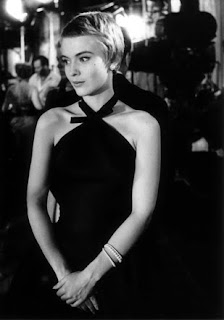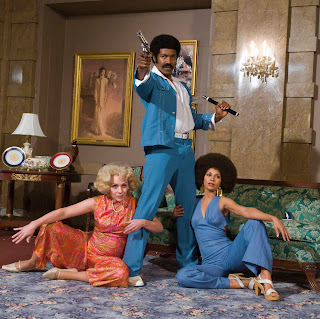At the Balboa (which has a new URL and redesigned website), I watched a fabulous double feature consisting of The Maid (2009) and A Serious Man (2009).
I first became aware of The Maid at this year's Mill Valley Film Festival. The Chilean film, directed by Sebastian Silva, was screened with subtitles. I previouly mentioned my desire to see it.
I enjoyed the film quite a bit. Catalina Saavedra in the title role gives a complex performance for a simple character. Raquel, the maid, is insecure with her position in the family (both formally and emotionally). She is envious of her employers and at times, quite cruel. Her headaches and dizzy spells are likely the result of self-induced stress. She has imposed herself on the family, particularly the matriarch, to the point that she is neither fish nor fowl. She is not fully embraced by the family as an equal but yet she is much more than an employee. At times, she exhibits maternal, sibling, romantic and childish tendencies. She is largely estranged from her own mother so Raquel has nothing but her employers. The film is bittersweet even with the heartwarming ending. I can't help but feel this woman has spent the best years of her life caring for someone else's family to her own emotional detriment.
A Serious Man is a Coen Brothers film.
Imaginatively exploring questions of faith, familial responsibility, delinquent behavior, dental phenomena, academia, mortality, and Judaism – and intersections thereof – A Serious Man is the new film from Academy Award-winning writer/directors Joel & Ethan Coen.
A Serious Man is the story of an ordinary man’s search for clarity in a universe where Jefferson Airplane is on the radio and F-Troop is on TV. It is 1967, and Larry Gopnik (Tony Award nominee Michael Stuhlbarg), a physics professor at a quiet Midwestern university, has just been informed by his wife Judith (Sari Lennick) that she is leaving him. She has fallen in love with one of his more pompous acquaintances, Sy Ableman (Fred Melamed), who seems to her a more substantial person than the feckless Larry. Larry’s unemployable brother Arthur (Richard Kind) is sleeping on the couch, his son Danny (Aaron Wolff) is a discipline problem and a shirker at Hebrew school, and his daughter Sarah (Jessica McManus) is filching money from his wallet in order to save up for a nose job.
While his wife and Sy Ableman blithely make new domestic arrangements, and his brother becomes more and more of a burden, an anonymous hostile letter-writer is trying to sabotage Larry’s chances for tenure at the university. Also, a graduate student seems to be trying to bribe him for a passing grade while at the same time threatening to sue him for defamation. Plus, the beautiful woman next door torments him by sunbathing nude. Struggling for equilibrium, Larry seeks advice from three different rabbis. Can anyone help him cope with his afflictions and become a righteous person – a mensch – a serious man?
I am a Coen Brothers fan. The first film I saw on VHS at my parents' house was Miller's Crossing (1990). They were late adaptapters to VHS. The first (and to date only) film I watched on an ipod was No Country for Old Men (2007). I also greatly enjoyed The Big Lebowski (1998) and Fargo (1996).
A Serious Man has been well reviewed and mentioned as a possible Oscar Best Picture nominee. I was not familiar with many of the actors in the cast so their performances were all the more effective. I enjoyed it from start to finish - the dybbuk, the Korean exchange student, the mentaculus, Sy Ableman, the goy's teeth, Jefferson Airplane, et al.
One aspect of the film that I have not seen any comments about are the striking (even frightening) eyes of Amy Landecker who plays Mrs. Samsky, the next door neighbor that likes to sunbathe nude. Her eyes are steel blue and with black eye shadow, the effect of her stare is quite discomforting. I could not hold up to her stare for more than a few seconds.

§§§
At the Roxie, I saw Bad Lieutenant: Port of Call - New Orleans (2009) starring Nicolas Cage, Eva Mendes and Val Kilmer and directed by Werner Herzog. Peter Hartlaub of the SF Chonicle wrote "you'll need to be a little bit screwed up in the head yourself to enjoy director Werner Herzog's drug-fueled journey in the abyss of the human condition." I'll give you one guess whether or not I enjoyed the film.
I can't say it any better than Hartlaub. I would say that I don't know if Cage overacts per se. It seems to me like he only has one mode - wooden, slow to react, alternating between feeble minded and psychotic. Sometimes it works such as Raising Arizona (1987) which was a Coen Brothers film, Moonstruck (1987) where ironically he has a wooden arm, Wild at Heart (1990), Red Rock West (1993), Face/Off (1997), Leaving Las Vegas (1999) and...well, the rest of the time it doesn't work. So it's been 10 years since I saw Nicholas Cage film I enjoyed.
The supporting characters in Bad Lieutenant add quite a bit of color - Val Kilmer was mentioned in the article. Shea Whigham, as politically john who beats up Mendes, stole every scene he was in. Herzog had to coach him to act that badly because no actor would dare interpret his character in such a manner.
Bad Lieutenant...New Orleans was much more enjoyable than the Abel Ferrara/Harvey Keitel film. No nuns are raped, you don't see full frontal male nudity and Keitel was bad in an ugly way. Cage is just as bad but he has more weird panache. Keitel jerked off to two teenage girls in a car; Cage screws a woman and makes her boyfriend watch at gunpoint. Keitel didn't hallucinate iguanas.
§§§
Also at the Roxie, I saw The Bicycle Thief (1948; Italian with subtitles) directed by Vittorio De Sica. I first saw this film in January 2003 at the Roxie. It is one of the most celebrated films in Italian cinema. It is considered the preeminent example of Italian Neorealism and ranks among the top films of all time.
Having appreciated the film in 2003 but not fully recognizing its greatness, I decided to see it again. I'm glad I did.
The plot centers on Antonio Ricci (Lamberto Maggiorani), an unemployed man in post WWII Italy. He lands a job hanging street posters or playbills. The only requirement is that he needs a bicycle. He's hocked his bike but his supportive hocks the bed linens so they can have money to get his bike out of the pawnshop. All is looking up for Ricci until a thief steals his bike. This starts Ricci and his son Bruno (7 year old Enzo Staiola) on a quest around the city to find his stolen bike. The search is ultimately fruitless but Ricci loses more than his bike. He loses his dignity and son's respect when he is caught stealing a bike.
That plot is deceptively simple. Ricci represent an entire society trying to navigate its way through the ruins of a city in a nation that lost the war. Ricci is a good and decent man but he is poor and can't get a job. When he finally gets a job, it is literally stolen from him. As he wanders the city, he sees that there are a lot of people worse off than him and that he is not equipped to deal with the rampant corruption and deceit that others will resort. Ricci finds the bicycle thief but he can't prove it's him and the thief's lack of morals preclude him from admitting his crime. Left with the impossible choice of remaining unemployed and not being able to provide for his family or stealing a bike, he chooses the latter. However, Ricci is not a thief and is quickly caught. Instead of admitting his desperation, he accepts his fate at the mob. It is only the compassion of the victim that saves him from serious trouble. In that sense, society is redeemed by the forgiveness of that man but surely Ricci is lost.
On second viewing, I am impressed with the performance turned in by Enzo Staiola as the son. In his debut role, Staiola imbues his character with more than any 7 year old (actor or character) could imagine or at least that I could imagine. I have read that Staiola is more like a small man acting opposite Maggiorani. Lamberto Maggiorani also debuted in The Bicycle Thief which makes his performance and the film all the more amazing. Both Staiola and Maggiorani had modest film careers and never acheived similar critical acclaim again. In both cases, their performances must not have been much different from their actual lives. That may impune their acting skills but it certainly says alot about their courage to basically play themselves on screen. I have to wonder if Maggiorani had faced a similar dilemma in his life. As for Staiola, Bruno has innocence that seems tempered by the reality of his situation but not conquered by it. Bruno wants to believe in his father and society but seems to know that he cannot. Still, he somehow suspends disbelief until it impossible to continue. His face seemed unusually mature for a 7 year old.
Several scenes stand out. Ricci & his son splurge by going to a restaurant for a meal. There is a boy at another table (from a wealthy family) who makes eye contact with Bruno and twirls his spaghetti in a manner to flaunt his good fortune while Bruno looks on hungrily and enviously. At the end, when Ricci is contemplating his crime, he sees hundred of bikes parked outside a soccer stadium and it drive him mad. Then he sits on a curb, head in hands, and a peloton cruises right in front of him further enticing him. When Ricci finds the thief and confronts him, the entire neighborhood come out to oppose him. The thief fakes a seizure and Ricci has a look of utter futility as he realizes that he can't do anything, the police won't do anything and the crowd (complicit in the crime or unsympathetic to his plight) won't do anything.
The proper translation of the film title, Ladri di biciclette, is The Bicycle Thieves. The second thief being Ricci. The mistranslated title has endured.




.jpg)









